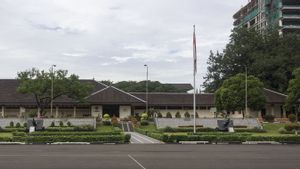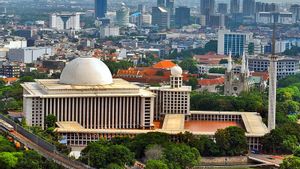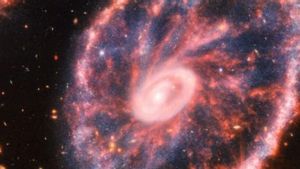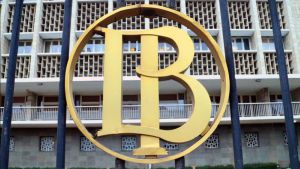JAKARTA - Steve Jobs' interest in the world of technology is second to none. Since childhood he has been interested in computers. That love grew until Jobs grew up. He and his friends founded the Apple Computer Company. The iPhone is a revolutionary product. However, its development is not easy. It requires large amounts of funds and technicians. Apple even almost went bankrupt because of it. Jobs' struggle paid off sweetly. The iPhone then transformed into a superior and revolutionary smart phone.
At first school was a boring space, at least for Steve Jobs. As a child, Jobs' desire to spend time at school was limited to two things: reading books and catching butterflies. This desire affected his life at school.
He grew up to be a bit of a naughty boy. Jobs liked to annoy his friends. One of the teachers named Hill tried to calm Jobs. According to him, Jobs has more potential. Jobs seems to prefer electronics. Therefore, the teacher gave him the equipment to make a simple camera. Jobs liked it. because of that Jobs was so diligent in studying at school.

The craze for electronics, especially computers, continues to grow. Jobs often attended every meeting of a computer club, the Homebrew Computer Club. He came there with his best friend, Steve Wozniak. Their friendship grew. Wozniak helped Jobs a lot. Vice versa.
In Jobs' eyes, Wozniak's skills as a technician were quite capable. Jobs racked his brains. An idea emerged. He wanted to start a company that marketed Wozniak's computers in 1976. His name was Apple Computer Company. The first revolutionary product produced was the Apple I computer.
“The Apple I was shown to the public for the first time at the Homebrew Computer Club. They put together 200 computers. The Apple I was sold as a motherboard (with CPU, RAM, and basic textual-video chips) instead of what is now called a full-fledged personal computer. The user needs to supply two different AC input voltages.”
“Connects an ASCII keyboard (not supplied with the computer) with a DIP connector (provides logic inverter and alpha lock chips in some cases), and connects the video output to an RF modulator if using a TV set. The Apple I was sold in July 1976 for $666.66. Wozniak wants this number because he wants a number that repeats itself,” said Hermawan Aksan in Steve Jobs' book: The Genius Brain Behind Apple's Success (2008).
The Beginning of the iPhone
Steve Jobs continues to innovate. Apple products began to appear on the market a lot. Apple II (1977), Apple III (1980), Apple Macintosh (1984), iMac (1998), and iPod (2001) are a series of innovations. However, Jobs was never satisfied.
He wants Apple to dominate the smartphone market. Because Jobs believes the potential for the upcoming mobile phone market is quite large. He also understands the needs of consumers who want one device for everything. From e-mail to listening to music. Jobs also aspired to be able to make a revolutionary cell phone which was later called the iPhone.
The struggle was not easy. Jobs had to fight with his own idealism. Moreover, the world of mobile phones is a new world for him and Apple. After all, Apple does not have strong experience building the mobile phone industry. But Jobs didn't care. Everything was broken down. The iPhone project began in 2004.
“That same year, Jobs assigned around 200 of its best technicians to develop mobile phones. In the developed prototype, a lot of problems arise because the feature does not work. Like making calls that often disconnect by themselves, the battery stops charging before it's full, data and applications often stop and can't be used. The long list of problems seems endless, making Jobs anxious," said Setia Gunawan and Bambang Dwi Atmoko in the book iPhone: From A to Z (2012).

The mobile phone project was deadlocked. In fact, it had become a serious problem for Apple. This development made Apple almost bankrupt. The condition is further exacerbated because Jobs has been predicted to launch this iPhone at the annual MacWorld event in 2007.
Jobs' big name is at stake. He plays tactics. A tactic that made Jobs have to work with a telecommunications company from the US, AT & T.
Jobs' skillful diplomacy led Apple and AT&T to work together. Millions of dollars in fresh funds and technical assistance came out. The assistance was very meaningful for Jobs to continue his innovation to give birth to the iPhone.
Not without reason, Jobs wanted to accept help from AT&T. The US telecommunications company gives Apple the freedom to be creative. Apple remains in full control of the project. Among other things regarding design to product marketing. The aid support made Jobs' dream come true.
A device that is expected to shake the world because it is more advanced than any product in the coming years has been born. iPhone, the name. Shortly before the iPhone was introduced to the public on January 9, 2007, Jobs first showed the iPhone to a legendary venture capitalist, John Doerr. The move was to convince John Doerr that a revolutionary cell phone had been born.
SEE ALSO:
"Steve reached into the pocket of his jeans and pulled out the first iPhone, Doer recalls. And he said, John, this device almost shut down my company. This was the hardest thing for us to work on. So I asked about the specifications. Steve said it had five radios in various waves, large processor power, lots of RAM [random access memory), and lots of gigabits of flash memory.
I've only heard of that much flash memory in such a small device. He also said there are no buttons - what will be used is the software for everything - and that in one device we will have a media player, a phone, and the best way to access the world's websites. Three in one," concluded Thomas L. Friedman in the book Thank You for Being Late (2018).
Steve Jobs was born in San Francisco, California on February 24, 1955. He died on October 5, 2011, in Palo Alto, California after a long illness of pancreatic cancer.
*Read other information about HISTORY or read other interesting articles from Detha Arya Tifada.
The English, Chinese, Japanese, Arabic, and French versions are automatically generated by the AI. So there may still be inaccuracies in translating, please always see Indonesian as our main language. (system supported by DigitalSiber.id)














